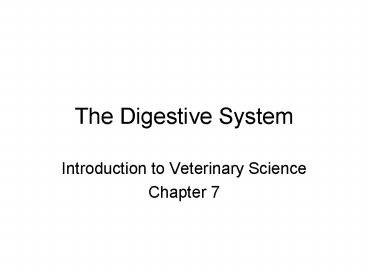The Digestive System - PowerPoint PPT Presentation
1 / 12
Title:
The Digestive System
Description:
The Digestive System. Introduction to Veterinary Science. Chapter ... Canine (1) Canine (1) Incisors (3) Incisors (3) Match the description with the tooth type ... – PowerPoint PPT presentation
Number of Views:58
Avg rating:3.0/5.0
Title: The Digestive System
1
The Digestive System
- Introduction to Veterinary Science
- Chapter 7
2
Structures of a Tooth
Enamel
Crown
Dentin
Pulp
Neck
Root
Cementum
Vein, Artery, and Nerve
3
Canine Dentition
Molars (2)
Premolars (4)
Canine (1)
Incisors (3)
Incisors (3)
Canine (1)
Molars (3)
Premolars (4)
4
Match the description with the tooth type
- ___Used for tearing food
- ___Absent in upper jaw of cattle (2)
- ___Cheek teeth (2)
- ___Root is twice as long as exposed crown
- ___Used for crushing and grinding food (2)
- ___Most caudally located
- ___Used to bite into food
- ___Tusks in pigs
- ___Flatter and tightly packed in herbivores (2)
- ___Used for age estimation
- Incisors
- Canines
- Premolars
- Molars
2
1,2
3,4
2
3,4
4
1
2
3,4
1
5
Intestinal Tract of a Dog
Esophagus
Duodenum
Rectum
Anus
Cecum
Ileum
Colon
Stomach
Jejunum
6
Intestinal Tract of a Horse
Dorsal Colon
Colon
Left Ventral Colon
Rectum
Anus
Duodenum
Esophagus
Stomach
Right Ventral Colon
Ileum
Cecum
Jejunum
7
Intestinal Tract of a Ruminant
Duodenum
Rumen
Colon
Esophagus
Rectum
Anus
Reticulum
Ileum
Omasum
Cecum
Abomasum
Jejunum
Spiral Loops
8
Functions of the Liver and Pancreas
- Liver
- Produces bile for storage in gallbladder. Bile
salts emulsify fat for faster digestion. - Stores vitamins and iron in reserve.
- Controls blood sugar levels and removes excess
amino acids from blood. - Pancreas
- Produces sodium bicarbonate to neutralize stomach
acid. - Secretes digestive enzymes and hormones (glucagon
and insulin).
- Secretions from the liver and pancreas empty into
the duodenum through ducts.
9
Intestinal LiningLarge circular folds, villi,
and microvilli increase surface area for
absorption.
10
Match the description with the digestive structure
- __Absorbs nutrients
- __An exocrine gland
- __Divided into duodenum, jejunum, and ileum
- __Has folds called rugae
- __Where bolus of food is formed
- __Contains ascending, transverse, and descending
sections - __Where digestion begins
- __Associated with the mesentery
- __Absorbs water
- __Divided into cardia, body, and pylorus
- __Where paristalsis first occurs
- __Drains through the hepatic duct
- __Secretes hydrochloric acid
- __Stores bile
- Mouth
- Esophagus
- Stomach
- Small intestines
- Colon
- Liver
- Gallbladder
- Pancreas
4
8
4
3
1
5
1
4
5
3
2
6
3
7
11
The Ruminant Stomach
Bacteria in the reticulorumen digest plant fiber
and release nutrients for the host animal to
absorb and use. This is a symbiotic relationship
in which both the animal and the bacteria benefit.
Fermentation vat, plant fiber digested by bacteria
Traps heavy objects, secondary site of
fermentation
Grinds food and extracts fluid
Secretes digestive enzymes, acts as true stomach
12
Rumination
- Rumination The process of bringing up food
material from the stomach to the mouth for
further chewing - Phase 1 Regurgitation
- Animal inhales, difference in pressure causes
rumen contents to enter esophagus, reverse
paristalsis moves food bolus into mouth - Phases 2 and 3 Remastication and Resalivation
- Food bolus (cud) is chewed repeatedly, liquid is
squeezed out and swallowed - Phase 4 Redeglutition
- Cud is reswallowed, next rumination cycle begins






























